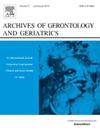Associations of metabolic dysfunction-related fatty liver disease and dementia risk: A prospective study based on the UK biobank
IF 3.5
3区 医学
Q2 GERIATRICS & GERONTOLOGY
引用次数: 0
Abstract
Background
Metabolic dysfunction-associated fatty liver disease (MAFLD) has garnered increasing attention for its potential link with dementia. This study aims to investigate the association between MAFLD and dementia, including its subtypes, to address existing knowledge gaps.
Methods
A total of 415,116 participants from the UK Biobank were included, with standardized screening criteria used to determine MAFLD diagnosis. Cox regression was employed to assess the relationship between MAFLD and dementia risk. Subgroup analyzes were conducted to provide further insights into the impact of MAFLD on dementia risk, and the mediation effect of inflammation was evaluated.
Results
Among the 150,509 MAFLD patients, there was a significantly elevated risk of dementia, with hazard ratios (HR) of 1. 526 (95 % CI = 1. 460–1. 596) for all-cause dementia, 1. 356 (95 % CI = 1. 266–1. 453) for Alzheimer's disease (AD), and 2. 206 (95 % CI = 2. 000–2. 434) for vascular dementia (VaD). MAFLD patients showed a significant reduction in gray matter volume in MAFLD patients (β = -0. 07, 95 % CI = -0. 17, -0. 01) and a marked increase in deep white matter lesion volume (P < 0. 001). Elevated inflammatory markers in MAFLD patients accounted for a mediation effect of 30. 8 %.
Conclusion
MAFLD substantially increases the risk of dementia, underscoring the importance of early intervention and prevention strategies targeting MAFLD to reduce dementia incidence.
代谢功能障碍相关脂肪性肝病与痴呆风险的关联:一项基于英国生物银行的前瞻性研究
代谢功能障碍相关脂肪性肝病(MAFLD)因其与痴呆的潜在联系而受到越来越多的关注。本研究旨在探讨MAFLD与痴呆之间的关系,包括其亚型,以解决现有的知识空白。方法从英国生物银行共纳入415,116名参与者,采用标准化筛选标准确定MAFLD诊断。采用Cox回归评估MAFLD与痴呆风险的关系。为了进一步了解MAFLD对痴呆风险的影响,我们进行了亚组分析,并评估了炎症的中介作用。结果在150509例MAFLD患者中,痴呆风险显著升高,风险比(HR)为1。(95% ci = 1)。460 - 1。596)对于全因痴呆,1。(95% ci = 1)。266 - 1。453)治疗阿尔茨海默病(AD);206 (95% ci = 2)。000 - 2。434)血管性痴呆(VaD)。MAFLD患者的灰质体积显著减少(β = -0)。07, 95% ci = -0。17日,0。01),深部白质病变体积显著增加(P <;0. 001)。在MAFLD患者中,炎症标志物升高占30%的中介作用。8%。结论MAFLD显著增加痴呆风险,强调针对MAFLD的早期干预和预防策略对降低痴呆发病率的重要性。
本文章由计算机程序翻译,如有差异,请以英文原文为准。
求助全文
约1分钟内获得全文
求助全文
来源期刊
CiteScore
7.30
自引率
5.00%
发文量
198
审稿时长
16 days
期刊介绍:
Archives of Gerontology and Geriatrics provides a medium for the publication of papers from the fields of experimental gerontology and clinical and social geriatrics. The principal aim of the journal is to facilitate the exchange of information between specialists in these three fields of gerontological research. Experimental papers dealing with the basic mechanisms of aging at molecular, cellular, tissue or organ levels will be published.
Clinical papers will be accepted if they provide sufficiently new information or are of fundamental importance for the knowledge of human aging. Purely descriptive clinical papers will be accepted only if the results permit further interpretation. Papers dealing with anti-aging pharmacological preparations in humans are welcome. Papers on the social aspects of geriatrics will be accepted if they are of general interest regarding the epidemiology of aging and the efficiency and working methods of the social organizations for the health care of the elderly.

 求助内容:
求助内容: 应助结果提醒方式:
应助结果提醒方式:


